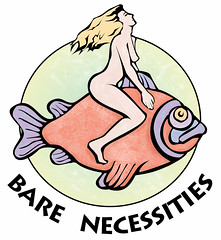 My nudist adventure was postponed by a day due to unavoidable conflicts so instead of the promised trip report, I am posting Part I of "A History of American Nudism." This article is quite lengthy and knowing firsthand how quickly the eyes tire while reading from a computer screen resulting in the ability to maintain interest, I will present this article in three parts.
My nudist adventure was postponed by a day due to unavoidable conflicts so instead of the promised trip report, I am posting Part I of "A History of American Nudism." This article is quite lengthy and knowing firsthand how quickly the eyes tire while reading from a computer screen resulting in the ability to maintain interest, I will present this article in three parts.For most of human history, nudity was a natural and normal part of life. People were nude when conditions favored it. In Ancient Greece, students exercised and received their education in the nude. Also, most athletes competed in the nude during the early Olympic Games. History shows that there is ample proof to support the fact that both the Greeks and Romans lived in a clothing optional society. Both cultures wore clothing when necessary or for certain social functions, but bathing and sports were openly enjoyed while naked. As exhibited by their sculpture and ceramics, the Greeks and Romans revered youth and physical fitness. To them the body was truly a work of divinity to be admired in its entirety.
A 16th century Christian group of Puritans strongly opposed the religious tolerance of the Church of England and with their exile to New England; they became the non-pleasure, morality enforcing people associated with Puritanism. They were so afraid of the lust that they refrained from bathing because in their eyes it promoted nudity. The Victorian Era that followed was also not accepting of nudity. In these times it was very common for persons to be expected to cover the legs to prevent sexual arousal. Oddly enough, this practice was even extended to the covering of piano legs and chair legs for the same reason. With the growth of industrialization and the continued “advancement” of civilization, along with the anti-nudity opposition among puritanical conservative and religious groups, humans in North America were slowly but surely conditioned to believe that they should be ashamed of their own bodies. Nudity was to be zealously covered, hidden and shaped at all times by clothing because it was considered an object of shame. The swimsuit, designed for “decency” purposes, first appeared in France in 1830 although it did not gain popularity in America until the 1890’s. These first bathing suits covered the entire body of both men and women, going all the way from the wrists to the ankles and up to mid-neck.
During the late 18th and early 19th centuries, a few famous Americans resisted the societal prohibition against nudity. Henry David Thoreau took daily naked walks which he called “air baths” and believed that they contributed to improved health. Benjamin Franklin was also in the habit of taking “air baths” each morning in his room. He made efforts to induce others to adopt the practice speaking highly of the benefits he derived from the activity. Franklin also particularly desired to spend time in the nude when doing mental work because he believed this practice made him a more effective thinker. Another nudist of note was President John Quincy Adams who reportedly regularly bathed nude in the Potomac River.
-- To be continued







No comments:
Post a Comment